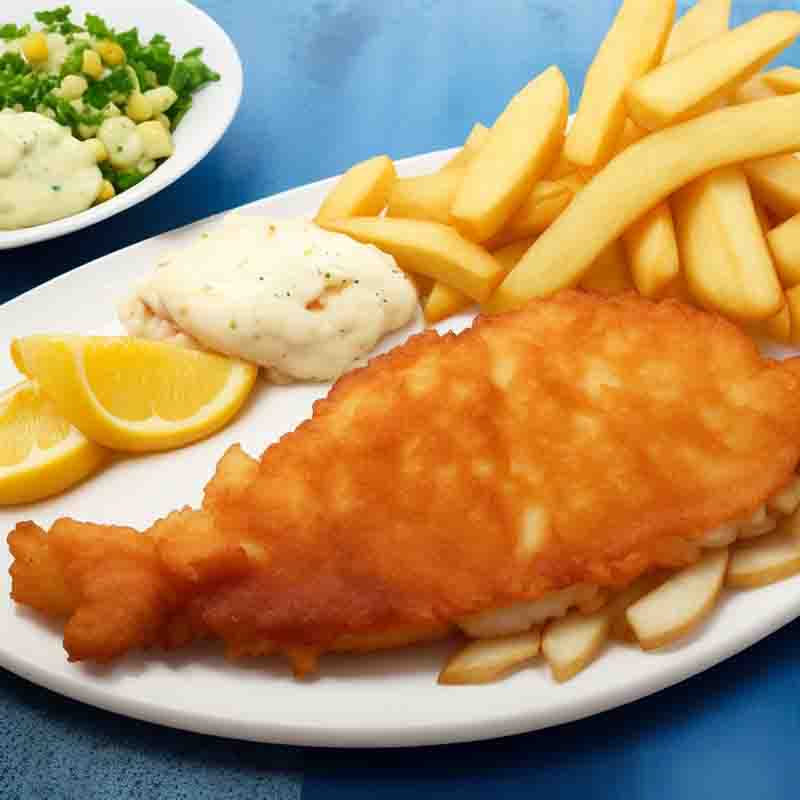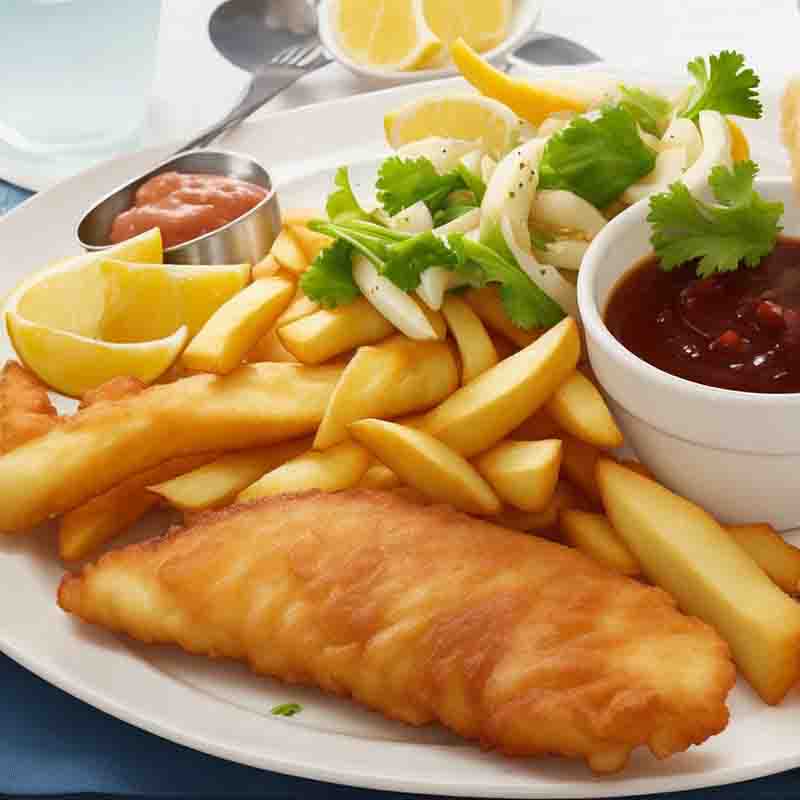British Culinary Seafood Classic
Fish'n Chips consists of succulent fillets of fish, commonly cod or haddock, encased in a delicate, seasoned batter that undergoes the alchemical transformation of deep-frying. The versatile potato, carefully cut into thick slices and also deep-fried, complements the battered flaky fish. Traditional accompaniments include malt vinegar and tartar sauce.

Fish'n Chips, a quintessential dish originating from the United Kingdom, represents a harmonious fusion of culinary elements that has transcended its regional roots to achieve global acclaim.
Fish'n Chips, a quintessential dish originating from the United Kingdom, represents a harmonious fusion of culinary elements that has transcended its regional roots to achieve global acclaim.
What makes Fish'n Chips a cultural touchstone is not just its culinary prowess but also its social significance.
Found in bustling seaside towns, neighborhood chippies, and upscale gastropubs alike, Fish'n Chips embodies accessibility and universal appeal.
Its enduring popularity has transformed fish'n chips from a local specialty to a global comfort food that bridges borders and connects people appreciating the uncomplicated pleasure of crispy fish and golden fries.
Fish'n Chips is a classic British dish that features battered and deep-fried fish, typically cod or haddock, served with thick-cut, golden-brown fries. Accompanied by traditional condiments such as malt vinegar, tartar sauce, or mushy peas, Fish'n Chips is a beloved culinary experience that has stood the test of time.
Fish’n Chips Timeline
Fish'n Chips is not just a meal but a gastronomic duo that tells a tale of tradition, craftsmanship, and cultural resonance.
Its enduring popularity speaks to its ability to transcend borders, inviting people worldwide to partake in the simple yet profound pleasure of crispy fish and golden fries.
| Time Period | Key Events |
|---|---|
| 1860s | Fish'n Chips is believed to have originated in England, with the first fish and chip shop opened by Joseph Malin in London in the 1860s. |
| 1870s | The dish gains popularity rapidly, and by the 1870s, it becomes a staple in working-class areas across the United Kingdom. |
| 1890s | The National Federation of Fish Friers is established in 1893, marking the formal recognition of the fish and chip trade. |
| 1920s | Fish and Chips start to be sold in the United States, with the dish gaining popularity in coastal areas and immigrant communities. |
| 1930s | The introduction of deep-fryers and innovations in batter recipes during the 1930s enhance the quality and consistency of Fish'n Chips. |
| 1940s-1950s | Fish'n Chips gains popularity during World War II due to fish being one of the few foods not subject to rationing. |
| 1960s-1970s | Fast-food chains and takeout establishments contribute to the widespread availability of Fish'n Chips, becoming a favorite among diverse demographics. |
| 1980s | Fish'n Chips undergoes a gourmet revival, with chefs experimenting with different fish varieties, batters, and accompaniments. |
| 1990s | The dish continues to evolve globally, with variations such as tempura-fried fish in Japan and different regional adaptations. |
| 2000s | Health-conscious adaptations, including grilled options and alternative batters, reflect changing dietary preferences. |
| 2010s | The rise of gastropubs and upscale fish and chip shops emphasizes quality ingredients and innovative culinary approaches to the traditional dish. |
| 2020s | Fish'n Chips remains a beloved classic, with a blend of tradition and innovation continuing to capture the taste buds of people worldwide. |
This timeline highlights key events and trends in the history of Fish'n Chips, showcasing its evolution from a working-class staple to a globally recognized and adaptable dish.
Authentic Fish and Chips Recipe

While the traditional preparation methods remain cherished, modern times have seen chefs and home cooks alike experimenting with variations of Fish'n Chips. Gourmet twists, alternative batters, and creative side dishes have found their place alongside the classic rendition.
Making Traditional and Authentic Fish'n Chips at Home
Preparing traditional and original fish'n chips is a rewarding culinary endeavor.
Here's a step-by-step guide to help you achieve the classic British dish with its iconic crispy exterior and tender fish inside:
Fish'n Chips Ingredients:
For the Fish:
-
4 fillets of white-fleshed fish (cod, haddock, or pollock)
-
1 cup all-purpose flour
-
1 teaspoon baking powder
-
1/2 teaspoon salt
-
1 cup beer (or carbonated water)
-
Oil for frying
For the Chips:
-
4 large potatoes, peeled and cut into thick strips
-
Salt to taste
-
Oil for frying
Instructions:
Prep the Potatoes
-
Peel the potatoes and cut them into thick strips resembling traditional chips.
-
Soak the potato strips in cold water for at least 30 minutes to remove excess starch.
-
Drain the water and pat the potato strips dry with a kitchen towel.
Prep the Batter
-
In a mixing bowl, combine the flour, baking powder, and salt.
-
Gradually add the beer (or carbonated water) to the dry ingredients, whisking continuously to create a smooth batter.
-
Let the batter rest in the refrigerator for 15-30 minutes.
Coat the Fish
-
Pat the fish fillets dry with paper towels to remove excess moisture.
-
Heat the oil in a deep fryer or a deep pan to 350-375°F (175-190°C).
-
Dip each fish fillet into the batter, ensuring it's fully coated.
Fry the Fish
-
Carefully lower the battered fish into the hot oil, frying in batches to avoid overcrowding.
-
Fry each fillet for about 4-6 minutes or until the coating is golden brown and crispy.
-
Use a slotted spoon to remove the fish from the oil and place it on a wire rack to drain excess oil.
Cook the Chips
-
Preheat the oil to 325°F (163°C) for the chips.
-
Carefully add the potato strips to the hot oil and fry until golden brown and crispy.
-
Remove the chips from the oil and place them on a paper towel to absorb excess oil.
-
Season the chips with salt immediately after frying.
Serve
-
Arrange the crispy fish and chips on a plate.
-
Serve with traditional accompaniments such as malt vinegar, tartar sauce, or mushy peas.
-
Optionally, garnish with fresh lemon wedges for a burst of citrus flavor.
Enjoy your homemade traditional Fish'n Chips with the perfect balance of crispy batter and succulent fish. This classic dish is a delightful treat that brings the flavors of a British seaside chippy right to your home kitchen.
The Origins and Cultural Significance of Fish'n Chips
Fish'n Chips, the iconic British dish, has become synonymous with comfort food, seaside feasts, and culinary excellence.
Its origins, steeped in history, trace back to the working-class streets of England.
From the bustling streets of the 19th century to contemporary gourmet adaptations, the dish has evolved while remaining a cherished symbol of comfort and community.
Whether enjoyed by the seaside, during wartime hardships, or in modern gastropubs, Fish'n Chips continues to capture the hearts and palates of people, embodying a timeless connection to the culinary heritage of the British Isles.
Fish'n Chips Origins: A Humble Beginning
The story of Fish'n Chips begins in the 19th century, where the industrial revolution was in full swing, transforming the urban landscape of Britain.
Street food was on the rise, offering convenient and affordable meals for the working class.
The birth of Fish'n Chips is often credited to two entrepreneurial establishments.
Joseph Malin is believed to have opened the first fish and chip shop in London around the 1860s.
Malin, a Jewish immigrant, initially sold fish as a side dish to pies.
Recognizing the potential of this combination, he transitioned to selling fish and chips exclusively, marking the beginning of a culinary revolution.
As the Industrial Revolution unfolded, urbanization led to an increased demand for quick and inexpensive meals. Fish'n Chips, wrapped in newspaper and served from carts or small shops, became the go-to comfort food for the masses.
Fish'n Chips quickly became a staple in the British diet, gaining popularity for its affordability and accessibility.
By the late 19th century, Fish'n Chips shops, known as "chippies," were widespread across Britain, reflecting the dish's rapid rise to popularity.
The dish's cultural significance goes beyond its taste, embedding itself in the social fabric of Great Britain.
With the expansion of railways in the late 19th century, coastal towns experienced a tourism boom.
Fish'n Chips became synonymous with trips to the seaside, wrapped in newspaper to be enjoyed on the sandy shores.
The seaside and Fish'n Chips became inseparable elements of British leisure.
Cultural Significance: A National Treasure
Fish'n Chips endured the challenges of World War I and World War II, emerging as a symbol of resilience and comfort during times of hardship.
Rationing meant that some traditional ingredients were scarce, but the dish remained a staple due to its ability to provide a satisfying and filling meal with minimal resources.
Fish'n Chips became a morale-boosting treat, offering a sense of normalcy and joy amid wartime difficulties.
In post-war Britain, Fish'n Chips continued to hold a special place in the hearts of the British people.
It became intertwined with British culture, evolving from a humble working-class meal to a national culinary icon.
As the British Empire expanded, so did the reach of Fish'n Chips.
The dish traveled with British expatriates and immigrants, finding its way to Australia, Canada, New Zealand, and beyond.
In each new location, Fish'n Chips adapted to local tastes and ingredients, becoming a global comfort food with regional variations.
Modern Revival and Gourmet Twists
In recent decades, there has been a resurgence of interest in traditional and artisanal approaches to Fish'n Chips.
Chefs and establishments have sought to elevate the dish by using high-quality, sustainable ingredients and experimenting with innovative batter recipes.
Gourmet variations, such as using different types of fish, unique batters, and creative accompaniments, have brought a fresh and modern perspective to this classic.
Fish'n Chips has become more than just a meal; it's a cultural phenomenon.
References to the dish abound in literature, music, and popular culture, emphasizing its place in the collective consciousness.
The distinctive aroma of frying fish and chips, the sound of the paper crinkling, and the shared experience of enjoying a "chippy tea" create a tapestry of memories and traditions.
Fish and Chips: FAQ
Are you curious about music, art, technology, fashion, lifestyle, and beer?
If so, then you need to subscribe to the free Likewolf newsletter.
100% privacy. When you sign up, we'll keep you posted.
Traditional Beer Experience
Authentic and Time Honored
